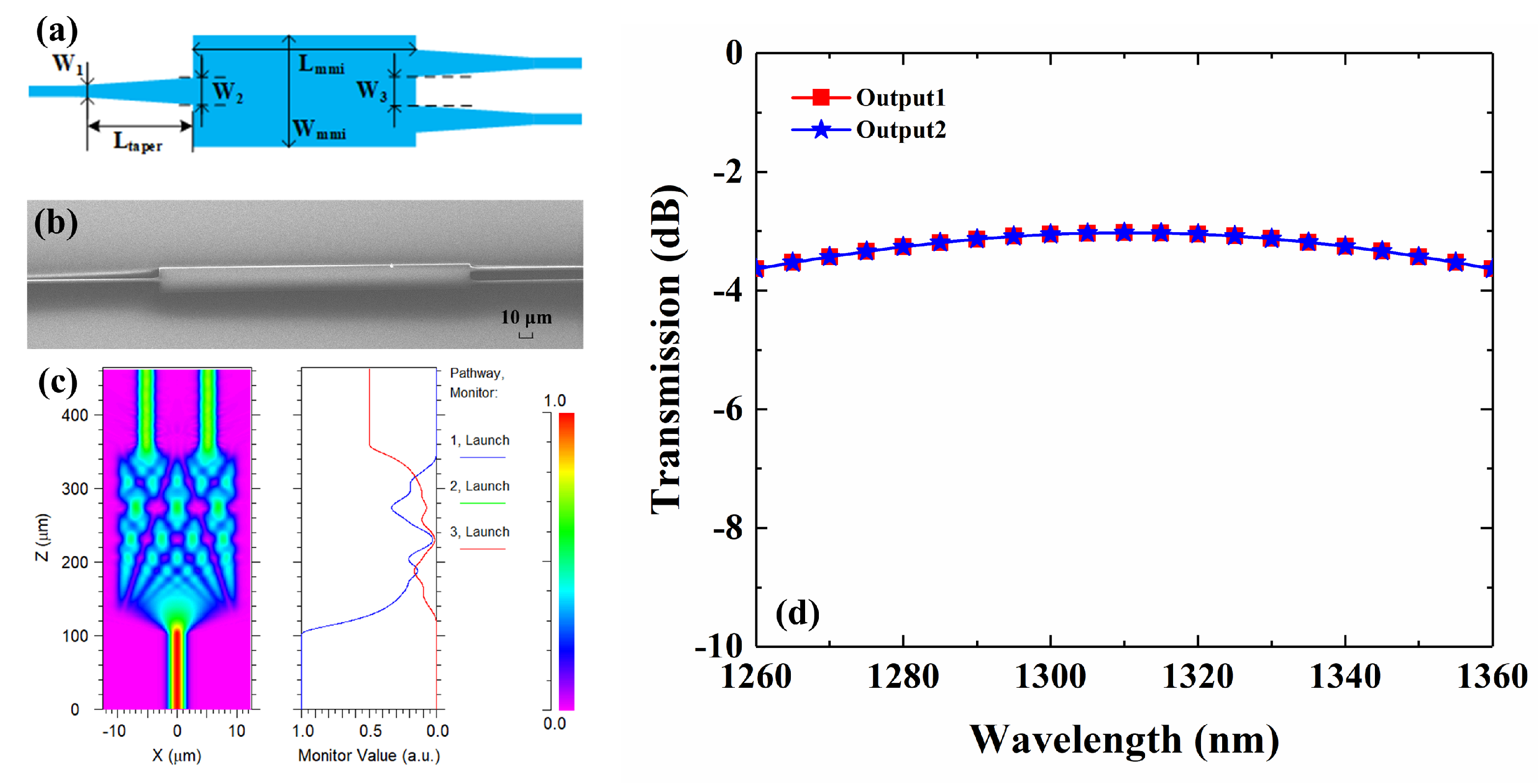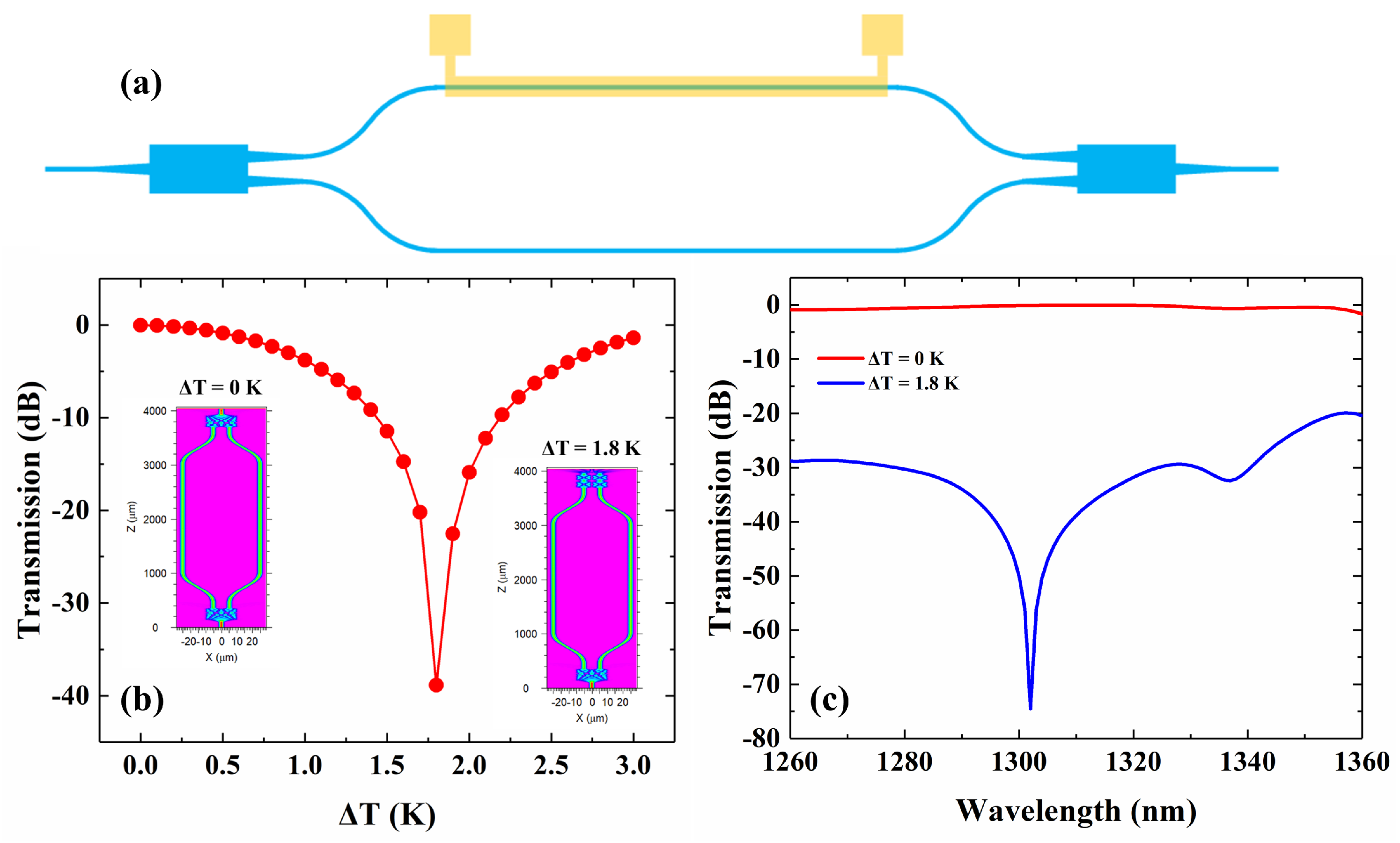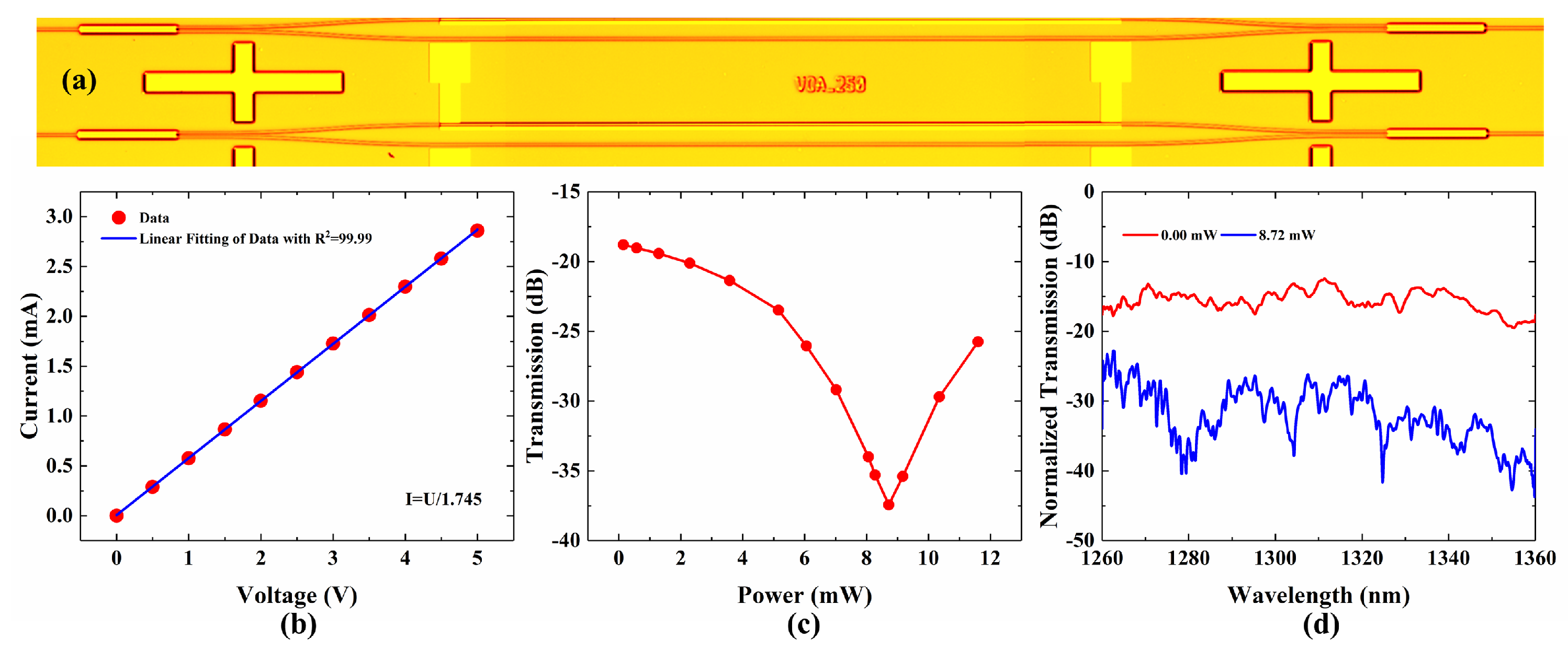Polymer/Silica Hybrid Waveguide Thermo-Optic VOA Covering O-Band
Abstract
:1. Introduction
2. Design and Simulation
3. Fabrication and Characterizing
4. Discussion
5. Conclusions
Author Contributions
Funding
Data Availability Statement
Conflicts of Interest
References
- Smit, M.K.; Van Dam, C. PHASAR-based WDM-devices: Principles, design and applications. IEEE J. Sel. Top. Quantum Electron. 1996, 2, 236–250. [Google Scholar] [CrossRef] [Green Version]
- Park, S.J.; Lee, C.H.; Jeong, K.T.; Park, H.J.; Ahn, J.G.; Song, K.H. Fiber-to-the-Home Services Based on Wavelength-Division-Multiplexing Passive Optical Network. J. Lightwave Technol. 2004, 22, 2582–2591. [Google Scholar] [CrossRef]
- Banerjee, A.; Park, Y.; Clarke, F.; Song, H.; Yang, S.; Kramer, G.; Kim, K.; Mukherjee, B. Wavelength-division-multiplexed passive optical network (WDM-PON) technologies for broadband access: A review [Invited]. J. Opt. Netw. 2005, 4, 737–758. [Google Scholar] [CrossRef]
- Cheung, S.; Tiehui, S.; Okamoto, K.; Yoo, S.J.B. Ultra-Compact Silicon Photonic 512 × 512 25 GHz Arrayed Waveguide Grating Router. IEEE J. Sel. Top. Quantum Electron. 2014, 20, 310–316. [Google Scholar] [CrossRef]
- Liu, L.; Chang, L.; Kuang, Y.; Li, Z.; Liu, Y.; Guan, H.; Tan, M.; Yu, Y.; Li, Z. Low-cost hybrid integrated 4 × 25 GBaud PAM-4 CWDM ROSA with a PLC-based arrayed waveguide grating de-multiplexer. Photonics Res. 2019, 7, 722–727. [Google Scholar] [CrossRef]
- Zhang, Z.; Sun, F.; Lin, P.; Xiao, G.; Wu, Y. Heat Control of an Integrated Silica VMUX Using Constant Working Power. IEEE J. Sel. Top. Quantum Electron. 2006, 12, 1054–1059. [Google Scholar] [CrossRef]
- Qing, F.; Junfeng, S.; Gang, Z.; Mingbin, Y.; Yuliang, L.; Guo-Qiang, L.; Dim-Lee, K. Monolithic Integration of a Multiplexer/Demultiplexer With a Thermo-Optic VOA Array on an SOI Platform. IEEE Photonics Technol. Lett. 2009, 21, 319–321. [Google Scholar] [CrossRef]
- Watanabe, K.; Hashizume, Y.; Nasu, Y.; Kohtoku, M.; Itoh, M.; Inoue, Y. Ultralow Power Consumption Silica-Based PLC-VOA/Switches. J. Lightwave Technol. 2008, 26, 2235–2244. [Google Scholar] [CrossRef]
- Young-Tak, H.; Jang-Uk, S.; Sang-Ho, P.; Sang-Pil, H.; Yongsoon, B.; Chul-Hee, L.; Young-Ouk, N.; Hyung-Jong, L.; Hyo-Hoon, P. Fabrication of 10-Channel Polymer Thermo-Optic Digital Optical Switch Array. IEEE Photonics Technol. Lett. 2009, 21, 1556–1558. [Google Scholar] [CrossRef]
- Liu, Y.F.; Wang, X.B.; Sun, J.W.; Sun, J.; Wang, F.; Chen, C.M.; Sun, X.Q.; Cui, Z.C.; Zhang, D.M. Improved performance of thermal-optic switch using polymer/silica hybrid and air trench waveguide structures. Opt. Lett. 2015, 40, 1888–1891. [Google Scholar] [CrossRef]
- Takahashi, M.; Yamasaki, S.; Uchida, Y.; Hasegawa, J. Compact and Low-Loss ZrO2-SiO2PLC-Based 8 × 8 Multicast Switch for CDC-ROADM Application. J. Lightwave Technol. 2016, 34, 1712–1716. [Google Scholar] [CrossRef]
- Ren, M.-Z.; Zhang, J.-S.; An, J.-M.; Wang, Y.; Wang, L.-L.; Li, J.-G.; Wu, Y.-D.; Yin, X.; Hu, X.-W. Low power consumption 4-channel variable optical attenuator array based on planar lightwave circuit technique. Chin. Phys. B 2017, 26, 074221. [Google Scholar] [CrossRef]
- Wu, X.; Liu, W.; Yuan, Z.; Liang, X.; Chen, H.; Xu, X.; Tang, F. Low Power Consumption VOA Array With Air Trenches and Curved Waveguide. IEEE Photonics J. 2018, 10, 7201308. [Google Scholar] [CrossRef]
- Chen, S.; Shi, Y.; He, S.; Dai, D. Variable optical attenuator based on a reflective Mach–Zehnder interferometer. Opt. Commun. 2016, 361, 55–58. [Google Scholar] [CrossRef]
- Yuan, P.; Wang, Y.; Wu, Y.; An, J. Variable optical attenuators based on SOI with 3 mum top silicon layer. Appl. Opt. 2019, 58, 4630–4636. [Google Scholar] [CrossRef]
- Nordstrom, M.; Zauner, D.A.; Boisen, A.; Hubner, J. Single-Mode Waveguides With SU-8 Polymer Core and Cladding for MOEMS Applications. J. Lightwave Technol. 2007, 25, 1284–1289. [Google Scholar] [CrossRef] [Green Version]
- Yang, B.; Zhu, Y.; Jiao, Y.; Yang, L.; Sheng, Z.; He, S.; Dai, D. Compact Arrayed Waveguide Grating Devices Based on Small SU-8 Strip Waveguides. J. Lightwave Technol. 2011, 29, 2009–2014. [Google Scholar] [CrossRef]
- Wang, X.B.; Sun, J.; Liu, Y.F.; Sun, J.W.; Chen, C.M.; Sun, X.Q.; Wang, F.; Zhang, D.M. 650-nm 1 × 2 polymeric thermo-optic switch with low power consumption. Opt. Express 2014, 22, 11119–11128. [Google Scholar] [CrossRef]
- Chen, C.; Niu, X.; Han, C.; Shi, Z.; Wang, X.; Sun, X.; Wang, F.; Cui, Z.; Zhang, D. Monolithic multi-functional integration of ROADM modules based on polymer photonic lightwave circuit. Opt. Express 2014, 22, 10716–10727. [Google Scholar] [CrossRef]
- Sun, S.-Q.; Niu, D.-H.; Sun, Y.; Wang, X.-B.; Yang, M.; Yi, Y.-J.; Sun, X.-Q.; Wang, F.; Zhang, D.-M. Design and fabrication of all-polymer thermo-optic variable optical attenuator with low power consumption. Appl. Phys. A 2017, 123, 646. [Google Scholar] [CrossRef]
- Zhang, Z.; Felipe, D.; Katopodis, V.; Groumas, P.; Kouloumentas, C.; Avramopoulos, H.; Dupuy, J.-Y.; Konczykowska, A.; Dede, A.; Beretta, A.; et al. Hybrid Photonic Integration on a Polymer Platform. Photonics 2015, 2, 1005–1026. [Google Scholar] [CrossRef]
- de Felipe, D.; Kleinert, M.; Zawadzki, C.; Polatynski, A.; Irmscher, G.; Brinker, W.; Moehrle, M.; Bach, H.-G.; Keil, N.; Schell, M. Recent Developments in Polymer-Based Photonic Components for Disruptive Capacity Upgrade in Data Centers. J. Lightwave Technol. 2017, 35, 683–689. [Google Scholar] [CrossRef]
- Raptakis, A.; Gounaridis, L.; Weigel, M.; Kleinert, M.; Georgiopoulos, M.; Mylonas, E.; Groumas, P.; Tsokos, C.; Keil, N.; Avramopoulos, H.; et al. 2D Optical Phased Arrays for Laser Beam Steering Based On 3D Polymer Photonic Integrated Circuits. J. Lightwave Technol. 2021, 39, 6509–6523. [Google Scholar] [CrossRef]
- Kim, S.M.; Lee, E.S.; Chun, K.W.; Jin, J.; Oh, M.C. Compact solid-state optical phased array beam scanners based on polymeric photonic integrated circuits. Sci. Rep. 2021, 11, 10576. [Google Scholar] [CrossRef] [PubMed]
- Park, T.-H.; Kim, S.-M.; Lee, E.-S.; Oh, M.-C. Polymer waveguide tunable transceiver for photonic front-end in the 5G wireless network. Photonics Res. 2021, 9, 181–186. [Google Scholar] [CrossRef]
- Huang, Q.; Wu, Y.; Jin, W.; Chiang, K.S. Mode Multiplexer With Cascaded Vertical Asymmetric Waveguide Directional Couplers. J. Lightwave Technol. 2018, 36, 2903–2911. [Google Scholar] [CrossRef]
- Chang, Z.; Chiang, K.S. All-optical loss modulation with graphene-buried polymer waveguides. Opt. Lett. 2019, 44, 3685–3688. [Google Scholar] [CrossRef]
- Song, Q.Q.; Chen, K.X.; Hu, Z.F. Low-Power Broadband Thermo-Optic Switch With Weak Polarization Dependence Using a Segmented Graphene Heater. J. Lightwave Technol. 2020, 38, 1358–1364. [Google Scholar] [CrossRef]
- Soldano, L.B.; Pennings, E.C.M. Optical multi-mode interference devices based on self-imaging: Principles and applications. J. Lightwave Technol. 1995, 13, 615–627. [Google Scholar] [CrossRef] [Green Version]




| Ref. | Platform | IL (dB) | ER (dB) | PC (mW) | Work Range | RT (μs) | FT (μs) |
|---|---|---|---|---|---|---|---|
| [12] | Silica on silicon with air trench | 0.7 | 30 | 155 | 1550 nm | N.A. | N.A. |
| [13] | Silica on silicon with | 0.8 | 39 | 95 | 1550 nm | N.A. | N.A. |
| [8] | Silica on silicon with suspended narrow ridge structure | 1.85 | 40 | 20 | 1539~1551 nm | 5000 | 5000 |
| [7] | Silicon on insulator | 8.5 | 15 | 35 | 1550~1560 nm (10 nm) | 2.8 | 7.1 |
| [14] | Silicon on insulator | 3.5 | 35.5 | 10.8 | 1580 nm | 5 | 7 |
| [9] | Polymer | 1.35 | 45 | 50 | 1530~1560 nm (30 nm) | N.A. | N.A. |
| [20] | Polymer with air trench | 9.3 | 40.2 | 2.8 | 1530~1610 nm (80 nm) | 612 | 584 |
| [10] | Polymer/silica with air trench | 9.6 | 29.6 | 3.4 | 1550 nm | 183.1 | 139.9 |
| This work | Polymer/silica | 12.43 | 18.64 | 8.72 | 1260~1360 nm (100 nm) | 184 | 180 |
Publisher’s Note: MDPI stays neutral with regard to jurisdictional claims in published maps and institutional affiliations. |
© 2022 by the authors. Licensee MDPI, Basel, Switzerland. This article is an open access article distributed under the terms and conditions of the Creative Commons Attribution (CC BY) license (https://creativecommons.org/licenses/by/4.0/).
Share and Cite
Yin, Y.; Yao, M.; Ding, Y.; Xu, X.; Li, Y.; Wu, Y.; Zhang, D. Polymer/Silica Hybrid Waveguide Thermo-Optic VOA Covering O-Band. Micromachines 2022, 13, 511. https://doi.org/10.3390/mi13040511
Yin Y, Yao M, Ding Y, Xu X, Li Y, Wu Y, Zhang D. Polymer/Silica Hybrid Waveguide Thermo-Optic VOA Covering O-Band. Micromachines. 2022; 13(4):511. https://doi.org/10.3390/mi13040511
Chicago/Turabian StyleYin, Yuexin, Mengke Yao, Yingzhi Ding, Xinru Xu, Yue Li, Yuanda Wu, and Daming Zhang. 2022. "Polymer/Silica Hybrid Waveguide Thermo-Optic VOA Covering O-Band" Micromachines 13, no. 4: 511. https://doi.org/10.3390/mi13040511
APA StyleYin, Y., Yao, M., Ding, Y., Xu, X., Li, Y., Wu, Y., & Zhang, D. (2022). Polymer/Silica Hybrid Waveguide Thermo-Optic VOA Covering O-Band. Micromachines, 13(4), 511. https://doi.org/10.3390/mi13040511






